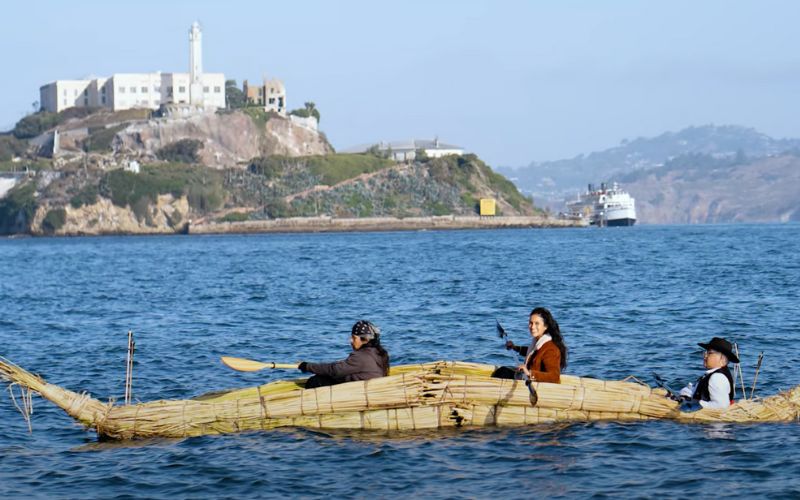
- Details
- By Kaili Berg
Non-profit news outlet Retro Report recently released a short film, The 1969 Occupation of Alcatraz Was a Catalyst for Indigenous Activism, about the 1969 occupation of Alcatraz Island, which sparked a wave of Native American activism in the 1970s. The occupation serves as an inspiration today Indigenous activists at the forefront of cultural and political movements in Indian Country.
Native News Online sat down with the film’s producer, Colleen Thurston (Choctaw Nation), to discuss how the occupation of Alcatraz was the beginning of the modern Indigenous rights era, what inspired her to create this film, and what she would like Native and non-Native audiences to gain from watching.
Thurston is an award-winning documentary filmmaker and assistant professor at the University of Oklahoma’s Gaylord College of Journalism and Mass Communication.
You can view The 1969 Occupation of Alcatraz Was a Catalyst for Indigenous Activism here.
This interview has been edited for clarity and length.
Native News Online: Tell me about the occupation of Alcatraz.
Colleen Thurston: The occupation of Alcatraz was a 19-month occupation of Alcatraz Island, which was the site of a former federal prison. That occupation was planned and implemented by a group of young Native students from UC Berkeley and San Francisco State. Notably led by LaNada War Jack and Richard Oakes, LaNada is the thread of this 13-minute piece.
LaNada talks about what led them to occupy Alcatraz and what the impact was all the way from the 19-month occupation to today. She also talks about the visibility of the Standing Rock occupation, which was kind of like the next generation of activists, and how that visibility has impacted the visibility of Natives generally in the media.
NNO: Why were moments like Alcatraz, Wounded Knee, and Standing Rock so important for Indigenous people?
Thurston: Alcatraz was, in some ways, the beginning of the modern Indigenous rights era. Obviously, since first contact, since colonization, we've been fighting for our rights here on our own lands. Alcatraz spurred a political movement in the same way as the black civil rights movement. Alcatraz kind of got that ball rolling for activists at Wounded Knee, Standing Rock, nd the Trail of Broken Treaties in Washington, DC.
NNO: Looking into the future, how have moments like these changed the narrative for ongoing Native American cultural and political movements?
Thurston: Jessica McEver is somebody who is featured in this documentary for Retro Report, and she put it really well that Alcatraz was the gold standard. These moments bring visibility and changes to how we are portrayed in the media. We're not the savages to be conquered or some sort of plot device in an old Western movie getting in the way of settler colonialism. We are empowered people here on our own lands with very loud voices and are portrayed as heroes in a way.
Young Native people can see these people in the media who are real-life warriors and heroes who are defending our people and our lands and creating generations of role models. I think it's worth noting that because being Indigenous on this continent is so politicized, you do see a lot of folks who are art activists and are activated and watching in that way and speaking up in that way.
NNO: What inspired you to want to become the producer of this documentary film? How is this documentary important to you?
Thurston: Retro Report reached out to me as they work with coalitions of educators who inform them about what's missing in the school curriculum. As anyone in Indian Country knows, our history is noticeably absent from the K-12 curriculum. Retro Report explained to me that they try to fill those gaps in the curriculum with these short documentary-style videos and weave history with contemporary stories.
They had a list of topics that they thought might be interesting, but they also just left it up to tell which story I thought was important. I thought that looking at the occupation of Alcatraz from the perspective of LaNada War Jack, who hasn't always been included in that narrative of Alcatraz, would be really fresh and necessary to hear. I was really inspired by the female leadership of these activist movements.
NNO: What do you hope audiences will take away from this documentary?
Thurston: I hope that Native audiences can watch the documentry and really feel empowered and feel proud of the 50-plus years of activism since the occupation of Alcatraz and what we've accomplished so far. Indian Country should be really proud of that.
For non-Native audiences, especially students who will be watching this in the classroom, I hope that they feel the same thing. I hope that they look at this and say, “Wow, I never knew this. This is an incredible story. Native folks are resilient and empowered, and they're never going to give up their relationship with the layout and stewardship of the land.”
I hope that's what they take away because I know the narratives that I was fed in history class were ones of destruction or sadness or how all these Nations were once great, but they no longer are. So, these narratives of empowerment, of hope, and of resiliency are incredibly important to be included in the classroom.
More Stories Like This
Zuni Youth Enrichment Project Takes Top Emerging Artist Apprentices to Phoenix for Artistic Exploration and Cultural ImmersionFrom Dishwasher to Award-Winning Chef: Laguna Pueblo's Josh Aragon Serves Up Albuquerque's Best Green Chile Stew
Rob Reiner's Final Work as Producer Appears to Address MMIP Crisis
Vision Maker Media Honors MacDonald Siblings With 2025 Frank Blythe Award
First Tribally Owned Gallery in Tulsa Debuts ‘Mvskokvlke: Road of Strength’
Help us defend tribal sovereignty.
At Native News Online, our mission is rooted in telling the stories that strengthen sovereignty and uplift Indigenous voices — not just at year’s end, but every single day.
Because of your generosity last year, we were able to keep our reporters on the ground in tribal communities, at national gatherings and in the halls of Congress — covering the issues that matter most to Indian Country: sovereignty, culture, education, health and economic opportunity.
That support sustained us through a tough year in 2025. Now, as we look to the year ahead, we need your help right now to ensure warrior journalism remains strong — reporting that defends tribal sovereignty, amplifies Native truth, and holds power accountable.
 The stakes couldn't be higher. Your support keeps Native voices heard, Native stories told and Native sovereignty defended.
The stakes couldn't be higher. Your support keeps Native voices heard, Native stories told and Native sovereignty defended.
Stand with Warrior Journalism today.
Levi Rickert (Potawatomi), Editor & Publisher


